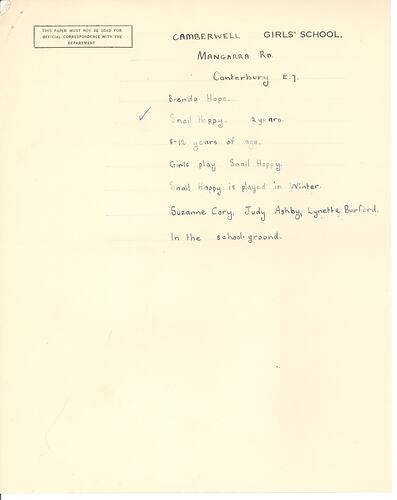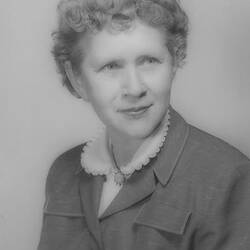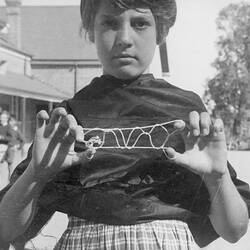Summary
Game name (and type): 'Snail Hoppy' (hopscotch game)
Alternative types: jumping games, hopscotch patterns
Handwritten description of the hopscotch game 'Snail Hoppy' composed for Dr Dorothy Howard by Brenda Hope, a twelve year old student at East Camberwell Girls Secondary School, in 1954-1955. Hope describes 'Snail Hoppy' as a game played by girls aged between 8 and 12 years in the school grounds during winter. She discusses the hopscotch pattern, which requires approximately thirty squares in a snail shell pattern, and provides an annotated, hand drawn diagram to illustrate her description. To play 'Snail Hoppy', players must hop to the centre of the hopscotch pattern and return to the beginning without stepping on a line or overbalancing. If successful, Hope explains that players repeat the process twice by jumping then 'scissors' jumping with legs crossed. If players complete the course successfully each time, they write their initials in one of the squares. Hope notes that no other player may stand in a square in which another's initials are marked; thus the game becomes increasingly difficult as more players occupy the squares. Hope lists other players of 'Snail Hoppy' including Suzanne Cory, Judy Ashby and Lynette Burford.
One of a collection of letters describing a children's game written to children's Folklorist Dorothy Howard between 1954 and 1955. Dr. Howard came to Australia in 1954-55 as an American Fulbright scholar to study Australian children's folklore. She travelled across Australia for 10 months collecting children's playground rhymes, games, play artefacts, etc. This letter, together with the other original fieldwork collected by Dr. Howard during this period, is preserved in the Dorothy Howard Collection manuscript files, part of the Australian Children's Folklore Collection (ACFC), Archive Series 3. The ACFC is an extensive collection documenting children's folklore and related research.
Physical Description
Handwritten game description in blue ink on paper. Comprises two sheets. First page features a letterhead printed in black ink; second page features a hand drawn illustration in pencil and border ruled in red pencil.
More Information
-
Collection Names
Australian Children's Folklore Collection, Dorothy Howard Collection
-
Collecting Areas
-
Acquisition Information
Cultural Gifts Donation from Dr June Factor, 18 May 1999
-
Acknowledgement
Donated through the Australian Government's Cultural Gifts Program.
-
Author
Brenda Hope - East Camberwell Girls' Secondary School (College), Greater Melbourne, Victoria, Australia, 1954-1955
-
Addressed To
-
Collector
-
Organisation Named
East Camberwell Girls' Secondary School (College), East Camberwell, Greater Melbourne, Victoria, Australia
-
Classification
-
Category
-
Discipline
-
Type of item
-
Overall Dimensions
203 mm (Width), 254 mm (Height)
Orientation: portrait. Dimensions include first page only.
-
Keywords




